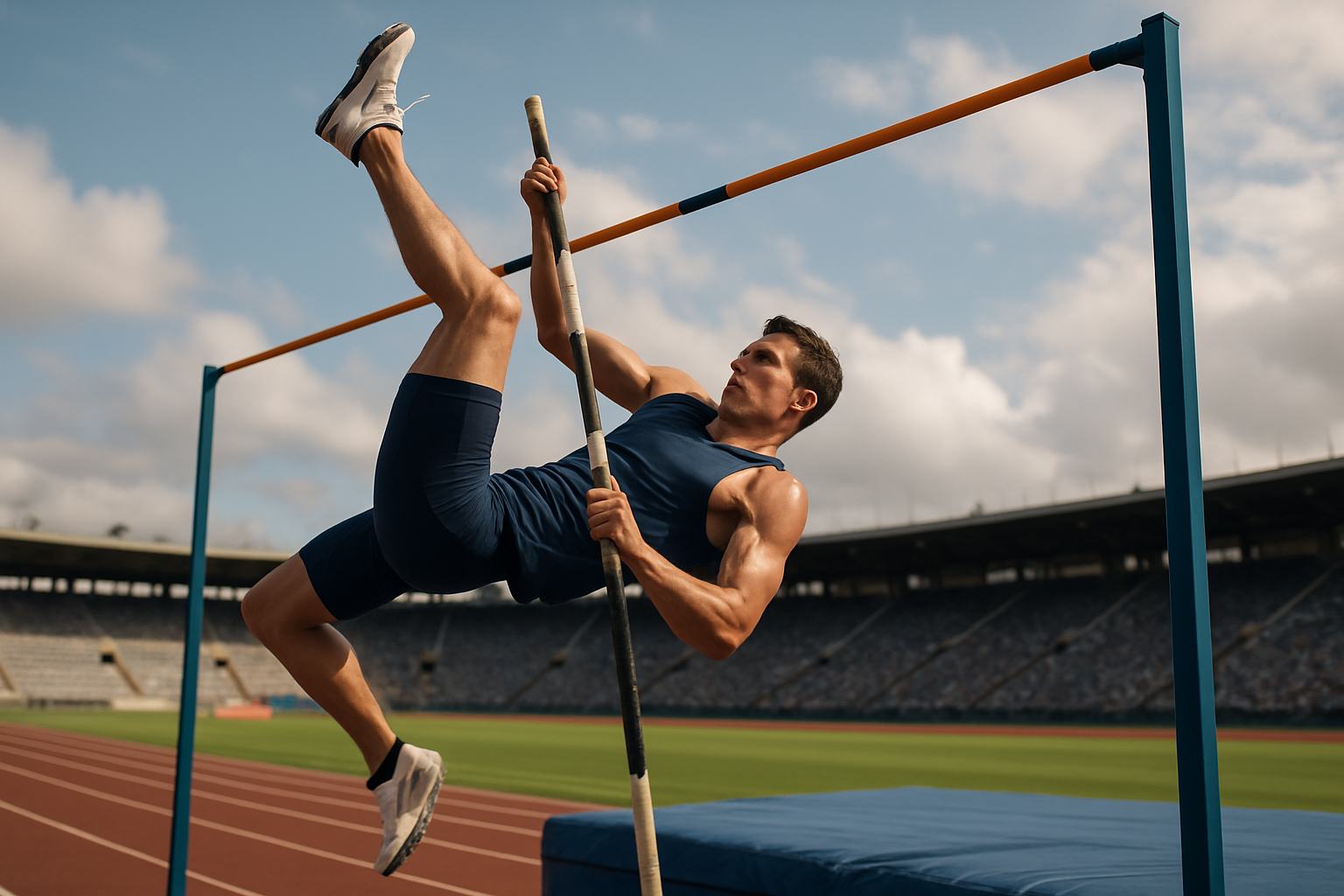Pole Vault: Soaring to New Heights in Track and Field
The pole vault, a captivating blend of athleticism and technical precision, has long been a cornerstone of track and field competitions. This gravity-defying event challenges athletes to clear a horizontal bar set at dizzying heights using a flexible pole and sheer human strength. As the sport continues to evolve, pole vaulters are pushing the boundaries of human potential, leaving spectators in awe and redefining what's possible in athletic achievement.

The early days of competitive pole vaulting saw athletes using rigid poles made of bamboo or metal. These materials limited the heights that could be achieved, with world records hovering around 4.5 meters (14.8 feet) in the early 20th century. The sport underwent a revolutionary change in the 1950s with the introduction of flexible fiberglass poles, allowing vaulters to bend the pole and store energy for a more powerful upward thrust.
The Biomechanics of Pole Vaulting
At its core, pole vaulting is a complex interplay of physics and human biomechanics. The event can be broken down into several key phases: the approach, plant, take-off, swing-up, extension, and bar clearance. Each phase requires precise timing, body positioning, and muscular coordination to achieve maximum height and a successful vault.
The approach is crucial, as it sets the foundation for the entire jump. Vaulters typically use a run-up of about 40 meters, gradually increasing their speed to around 9 meters per second. This kinetic energy is then transferred into the flexible pole during the plant phase. As the pole bends, it stores elastic potential energy, which is later converted back into kinetic energy, propelling the athlete upwards.
The swing-up and extension phases require immense upper body and core strength, as the vaulter must pull themselves up the bending pole and invert their body. The final bar clearance demands perfect timing and body control to arc over the bar without touching it. This intricate sequence of movements makes pole vaulting one of the most technically demanding events in track and field.
Training Regimens and Techniques
Successful pole vaulters must develop a diverse skill set that combines speed, strength, gymnastic ability, and technical proficiency. Training programs are multifaceted, incorporating sprint work, weightlifting, gymnastics, and countless repetitions of vaulting technique.
Speed training is essential, as a faster approach translates to more energy transferred into the pole. Vaulters often incorporate sprint drills and plyometric exercises to improve their acceleration and top-end speed. Strength training focuses on developing power in the legs for the take-off, as well as upper body and core strength for the swing-up and inversion phases.
Gymnastic training plays a crucial role in developing the body awareness and spatial orientation needed for the complex movements in the air. Many elite vaulters have backgrounds in gymnastics, which provides them with an advantage in body control and aerial awareness.
Technical training on the pole itself is, of course, paramount. Vaulters spend countless hours perfecting their grip, plant, and bar clearance techniques. This often involves the use of video analysis and specialized coaching to fine-tune every aspect of the vault.
Technological Advancements in Equipment
The evolution of pole vaulting technology has been a key factor in the steady increase of world records over the years. The shift from rigid poles to flexible fiberglass and carbon fiber composites in the 1950s and 1960s marked a turning point in the sport. These materials allow for greater energy storage and release, enabling vaulters to achieve unprecedented heights.
Modern poles are highly specialized, with different stiffness ratings and lengths tailored to each athlete’s weight, speed, and technique. The selection of the right pole for each attempt is a critical decision that can make the difference between success and failure.
Advancements have also been made in other equipment areas. High-tech track surfaces provide optimal conditions for the approach run, while specialized vaulting shoes offer a perfect balance of grip and lightweight construction. Even the landing area has seen improvements, with foam pits becoming deeper and more forgiving, allowing athletes to train and compete with greater confidence.
The Mental Game of Pole Vaulting
While the physical aspects of pole vaulting are undoubtedly demanding, the mental challenges of the sport are equally significant. Vaulters must contend with the fear of heights, the risk of injury, and the pressure of competition. Developing mental toughness and focus is crucial for success in this high-stakes event.
Many elite vaulters incorporate visualization techniques and mindfulness practices into their training regimens. These mental strategies help athletes maintain composure and execute their techniques flawlessly under pressure. The ability to stay calm and focused while attempting to clear heights of 5 to 6 meters is a hallmark of champion pole vaulters.
The psychological aspect of pole vaulting also extends to strategy during competition. Deciding when to enter the competition, which heights to attempt, and when to pass on certain heights can all impact an athlete’s chances of victory. This chess-like element adds another layer of complexity to the sport, requiring athletes to be not just physically prepared but also tactically astute.
World Records and Notable Performances
The progression of world records in pole vault serves as a testament to the continuous improvement in technique, training, and technology. The current men’s world record stands at an astonishing 6.21 meters (20 feet 4.5 inches), set by Armand Duplantis of Sweden in 2022. On the women’s side, Yelena Isinbayeva of Russia holds the record at 5.06 meters (16 feet 7 inches), set in 2009.
These heights represent the pinnacle of human achievement in the sport, but they are by no means the end of the road. Athletes continue to push the boundaries, with many speculating that a 6.30-meter vault for men and a 5.20-meter vault for women could be within reach in the coming years.
Notable performances in Olympic and World Championship competitions have cemented pole vault’s status as one of the most exciting events in track and field. The battle for gold often comes down to nerves of steel and perfect execution under immense pressure, providing spectators with unforgettable moments of athletic brilliance.
The Global Landscape of Pole Vaulting
While traditionally dominated by European and North American athletes, pole vaulting has become increasingly global in recent years. Countries like Brazil, China, and Japan have produced world-class vaulters, broadening the competitive landscape and bringing new techniques and training methodologies to the forefront.
The sport has also seen growth at the grassroots level, with more schools and clubs offering pole vaulting programs. This increased participation has led to a deeper talent pool and more competitive fields at international competitions.
However, challenges remain in expanding the sport’s reach. The specialized equipment and facilities required for pole vaulting can be a barrier to entry in many parts of the world. Efforts are being made by international governing bodies to provide resources and support to developing nations, aiming to make pole vaulting more accessible on a global scale.
The Future of Pole Vaulting
As pole vaulting continues to evolve, several trends are shaping the future of the sport. Advances in biomechanical analysis and sports science are providing athletes and coaches with more data than ever before. This wealth of information is being used to refine techniques, optimize training programs, and push the limits of human performance.
Virtual reality and augmented reality technologies are beginning to find applications in pole vault training. These tools allow athletes to visualize and practice their techniques in a safe, controlled environment, potentially accelerating skill development and reducing the risk of injury.
Environmental concerns are also influencing the sport, with a growing focus on sustainable equipment manufacturing and eco-friendly facility design. Biodegradable materials for landing pits and recycled components in poles are areas of ongoing research and development.
The Enduring Appeal of Pole Vaulting
Despite its technical complexity and the specialized skills required, pole vaulting continues to captivate audiences and inspire new generations of athletes. The combination of raw power, graceful technique, and the thrilling moment of flight creates a spectacle unlike any other in track and field.
For the athletes themselves, the pursuit of new heights provides a lifelong challenge. The incremental nature of improvement in pole vaulting means that even seasoned veterans can continue to set personal bests and push their limits. This constant striving for perfection is at the heart of the sport’s enduring appeal.
Conclusion: A Sport That Defies Gravity and Expectations
Pole vaulting stands as a testament to human ingenuity and athletic prowess. From its humble origins as a practical skill to its current status as an Olympic event, the sport has continuously evolved, pushing the boundaries of what’s possible when human strength meets cutting-edge technology.
As we look to the future, pole vaulting is poised to reach new heights, both literally and figuratively. With ongoing advancements in training methods, equipment design, and a growing global talent pool, the sport promises to continue thrilling audiences and challenging athletes for generations to come.
Whether viewed as a supreme test of athleticism or a poetic defiance of gravity, pole vaulting remains one of the most compelling events in the world of sports. It embodies the human spirit of adventure and the relentless pursuit of excellence, inspiring us all to aim higher and push beyond our perceived limitations.





